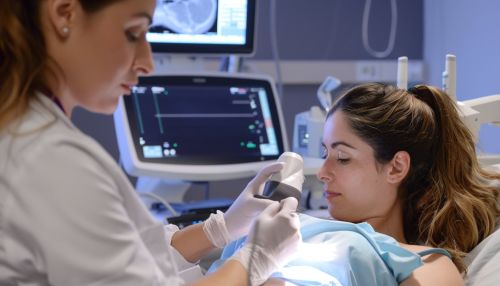Abdominal sonography
Introduction
Abdominal sonography, also known as abdominal ultrasound, is a non-invasive imaging technique used to visualize the organs and structures within the abdomen. This diagnostic tool uses high-frequency sound waves to produce images of the internal structures, providing valuable information about the functioning and pathology of the organs within the abdomen.
Principles of Abdominal Sonography
Abdominal sonography is based on the principles of ultrasound, a form of imaging technology that utilizes sound waves of high frequency that are beyond the range of human hearing. These sound waves are transmitted into the body, where they encounter tissues, organs, and fluids. Depending on the density and composition of the encountered material, some of the sound waves are reflected back to the transducer, while others continue to travel deeper into the body. The reflected waves, or echoes, are then processed by the ultrasound machine to create an image of the internal structures.
Indications for Abdominal Sonography
Abdominal sonography is indicated for a variety of conditions and symptoms. It is commonly used to investigate abdominal pain, abnormal liver function tests, kidney disease, gallstones, or an abdominal mass. It can also be used to guide procedures such as biopsies. Furthermore, it is a valuable tool in the assessment of trauma patients, as it can quickly identify internal bleeding or other injuries.
Procedure
The procedure for abdominal sonography is straightforward and typically takes between 15 to 60 minutes. The patient is usually asked to lie on an examination table, and a clear, water-based gel is applied to the skin over the abdomen. This gel helps to eliminate the air between the skin and the transducer, thereby facilitating the transmission of the ultrasound waves into the body. The sonographer then moves the transducer over the abdomen, adjusting the controls on the ultrasound machine to obtain the best possible images.
Interpretation of Results
Interpreting the results of abdominal sonography requires a thorough understanding of the anatomy and physiology of the abdominal organs, as well as knowledge of various pathological conditions that can affect these organs. The sonographer must be able to differentiate between normal and abnormal findings, and to recognize the signs of specific diseases or conditions. For example, gallstones may appear as echogenic (bright) structures within the gallbladder that cast an acoustic shadow, while a kidney stone may appear as a bright structure within the kidney with a 'twinkling' artifact behind it.
Limitations and Challenges
Despite its many advantages, abdominal sonography also has certain limitations. For instance, it may not provide good images in patients who are obese, as the increased amount of fatty tissue can attenuate the ultrasound waves. It may also be less effective in visualizing organs that are filled with gas, such as the stomach or intestines, as gas scatters the ultrasound waves. Moreover, the quality of the images obtained with abdominal sonography is highly dependent on the skill and experience of the sonographer.
Future Directions
Advancements in technology are continually improving the capabilities of abdominal sonography. For example, the development of three-dimensional (3D) ultrasound allows for more detailed visualization of the abdominal organs. Furthermore, contrast-enhanced ultrasound, which involves the use of microbubble contrast agents, can improve the visualization of blood flow and tissue perfusion in the abdomen. These and other advancements are expected to further expand the applications and improve the diagnostic accuracy of abdominal sonography.


